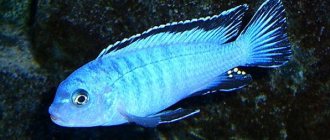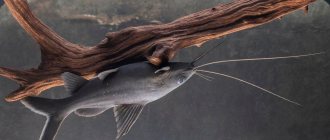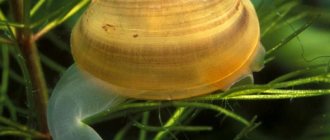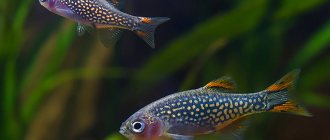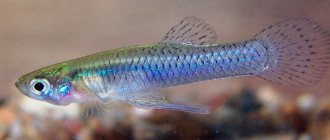Mystus striped (orca shifter, Asian catfish) is an extravagant representative of aquarium inhabitants. Mystus has a snow-white belly, the body is decorated with stripes shining with mother-of-pearl, and long antennae and playfully winking eyes complement the already unusual image. Mystus also differs in character: sometimes calm, sometimes cocky. She's definitely fun to watch.
Appearance
Mystus striped belongs to the catfish family. The fish is distinguished by a specific body , reminiscent of a spindle in shape. The size of an adult is about 15-20 cm, but there are also smaller catfish suitable for living in small aquariums.
The unusual color of the fish is also attractive. The surface of its back is colored brownish-gray, and its light belly appears pearlescent and shimmers in the light. Two almost parallel pearlescent stripes also run along the entire body of the fish, which is how it got its name - striped mystus.
Like other catfishes, mystus is characterized by pronounced whiskers located above the upper and lower lip. It is interesting that the mustache is the main tactile organ of the Asian catfish, allowing it to navigate in space when it is darkened or gets into dense thickets of algae.
The bulging eyes of the striped mystus make its face playful and funny, especially since it has one characteristic habit - winking periodically. These fish have a very long tail , but the pelvic and pectoral fins , on the contrary, are graceful and small.
The gender of striped mystus is very easy to identify. Males are significantly smaller than females in size, and in addition, they have a specific process, called by scientists the urogenital papilla.
Description and natural habitat
The singing catfish is a member of the armored catfish family (Doradidae). The cylindrical body resembles an arrow. The color is dark brown or black, with white or yellow stripes running along the body. In fry, the pattern is clearly and brightly expressed, but with age it blurs and turns pale.
In nature, it lives in tropical rivers of Colombia, Venezuela and Brazil, such as the Amazon, Essequibo, Trocantins, Parnaiba, Orinoco, as well as in French Guiana, the Republic of Suriname. It grows 20-25 cm in length and lives 20 years.
Optimal conditions of detention
The main thing that mystus striped needs for comfortable living in an artificial environment is a large and spacious aquarium, the volume of which is at least 150 liters. This is due to the excessive activity and mobility of the fish. Asian catfish love to swim, play with their relatives, chase each other, moving quickly along the water surface.
In addition, these fish jump quite well and high, therefore, in order to protect the catfish and protect it from death when jumping out of the aquarium, the tank should be covered with a special, transparent protective glass.
Mystus striped in nature leads a gregarious lifestyle and absolutely cannot stand loneliness.
Experts recommend that aquarists purchase at least 4-5 individuals.
Otherwise, the catfish will become sad, its activity will decrease and its susceptibility to various kinds of life-threatening diseases will increase.
In its natural environment, the striped mystus likes to periodically retire to rest, especially during the daytime. Therefore, in order for the fish to feel as comfortable as possible, the artificial pond must be decorated with various driftwood, branches, grottoes and caves, which will serve as a reliable refuge for Asian catfish.
Lovers of aquatic and above-water green spaces should take into account that the striped mystus, which loves plant food, will constantly nibble on the leaf blades of plants. You can distract his attention by periodically adding chopped herbs, pieces of raw vegetables and fruits to the aquarium.
What are the diseases of pearl gouramis?
All fish species have a characteristic list of the most common diseases, and Pearl Gourami is no exception. Remember that the disease of one fish in an aquarium can cause the death of all aquarium animals, so it is better to try to prevent diseases than to treat them. Fish are most often susceptible to diseases due to poor living conditions, injuries during transportation, sudden changes in temperature and water parameters, the quality of the food supplied, especially live food, which can be infected with various parasites. Don’t forget about quarantine for new fish, because it’s very sad to reproach yourself for the death of your much-loved fish after adding a seemingly healthy, but in fact sick, fish to them.
The most common diseases of pearl gourami, as well as other types of gourami, include: lymphocystosis, pseudomonosis, aeromonosis.
Lymphocystis is a viral disease that affects the skin of fish and changes the cells of the mucous membrane. Blisters appearing on the skin can be seen even with the naked eye. The affected cell grows, generates new viruses, and then breaks and all the viruses fall into the water. Most often, the disease appears on the outer edges of the fins, and only then affects cells throughout the body.
Pseudomonosis is a peptic ulcer disease characteristic of many types of aquarium fish, the causative agent of which is aquatic microorganisms from the group of pseudomonas. These organisms can get into the aquarium with soil, plants, and infected fish. When the disease occurs, dark spots form on the fish’s body and then transform into bloody ulcers. And through these ulcers, the doors to other viral infections are opened into the fish’s body. It is best to treat the fish in a separate quarantine aquarium without plants. For treatment, use a solution of potassium permanganate at the rate of 0.5 grams per 10 liters of water. The infected fish are kept in this composition for 15 minutes. if you do not have a quarantine aquarium, then the infected fish can be treated in a general aquarium with bicillin-5, adding 500,000 units of the drug per 100 liters of water, repeat every other day at least six times.
Aeromonosis is an infectious disease, usually caused by the bacterium Aeromonos punctata, which develops in very polluted and cold aquariums.
Sick fish become inactive, lie down on the ground and do not eat. They have a bloated abdomen and “ruffled” scales. Blood stains appear all over the body and fin. This disease is highly contagious and difficult to cure. In this connection, it is often recommended to completely disinfect the aquarium and destroy the fish.
All of the above is just the fruit of observing this type of aquarium fish and collecting various information from owners and breeders. We would like to share with visitors not only information, but also live emotions that allow us to understand the world of aquariums more fully and subtly. Register at https://fanfishka.ru/forum/, participate in discussions on the forum, create profile topics where you will talk about your pets in the first person and from the horse’s mouth, describe their habits, behavior and content, and share with us your successes and joys, share your experiences and learn from the experiences of others. We are interested in every bit of your experience, every second of your joy, every awareness of a mistake, which makes it possible for your comrades to avoid the same mistake. The more of us there are, the more pure and transparent drops of goodness there are in the life and everyday life of our seven billion society.
Parameters of the aquatic environment
Beginners should not get Mystus striped, as this fish requires care and constant monitoring of water parameters, to which it is extremely sensitive. The following parameters are considered optimal for keeping Asian catfish:
- hardness – up to 24;
- temperature regime – from +22° to +27°С;
- acidity – about 6-7.
You will also need to equip the tank with a good filter and aerator.
The striped mystus is a big tidy person, so the tank where it lives will have to be cleaned regularly and the water replaced at least a quarter of the time every week.
This procedure will also reduce nitrate levels in the aquatic environment, which have an extremely negative effect on the condition and health of representatives of the catfish family.
Striped mystuses prefer moderate and slightly diffused lighting. They cannot tolerate bright, intense illumination, as well as a lack of light.
Features of feeding
Striped mystuses are predators by nature. Therefore, they need live food with a high percentage of protein. The best option would be bloodworms, earthworms, as well as specialized ready-made frozen or dry food, developed by specialists taking into account all the characteristics and needs of the catfish body.
In addition, it is recommended to include plant foods in the diet in the form of greens, chopped lettuce or spinach, and oatmeal. Asian catfish are omnivores and not picky eaters. However, the basis of their menu should be protein live food. It is best to give food in small portions, since the striped mystus feeds exclusively from the water surface. When food residue settles to the bottom of the aquarium, it will have to be cleaned and siphoned (read more about how to siphon soil correctly).
Polypterus video compilation
https://youtube.com/watch?v=CWO5qiqBuS0
+
Category: Aquarium articles / Aquarium fish | Views: 25 557 | Date: 5-11-2017, 14:56 |
We also recommend reading:
- — The crucian carp have learned to ferment sugar into alcohol!
- — Clarius
- — Cichlazoma Eliot
- — Biotope aquarium as a form of aquarium art!
- — Arowana
Compatibility with other aquarium inhabitants
Mystus striped is a predatory fish and it naturally has hunting instincts, so in no case is it recommended to keep it in the same artificial reservoir with small ornamental fish, as they will be perceived by the Asian catfish as potential prey and nutritious live food.
Other representatives of the catfish family, as well as fish that are similar in size and have low fins, will be good neighbors for the striped mystus. The Asian catfish is very friendly and enjoys playing with its neighbors, organizing real races in the aquarium, and, as aquarists themselves note, watching this process is an extremely funny and exciting activity.
Habitat
Mystus striped or Indian killer whale catfish prefers freshwater streams and lakes . Feels free in both standing and running water.
More often he chooses places where there is enough vegetation near the shore, as this allows him to obtain an additional source of food.
Very rarely it can be found in small sea bays. Already from the name it is clear that it prefers rather warm waters for its habitat, therefore it is found in the wild in India, Pakistan, Nepal and Sri Lanka.
Familiarize yourself with the features of keeping such catfish as: aquarium catfish, corydoras catfish, changeling catfish, plecostomus catfish and brocade catfish.
Features of behavior in the aquarium
Mystus striped is an overly mobile, active fish. But she leads a predominantly nocturnal lifestyle. It is with the onset of dusk that her playful and perky disposition is especially evident. Despite their predatory nature, Asian catfish are non-aggressive towards their relatives and other aquarium inhabitants, whose size does not allow them to be perceived as possible prey.
However, in addition to its desire, the striped mystus can cause serious injuries to ornamental fish with long fins. Mistaking them for plants, the Asian catfish often gnaws off pieces of fins. Therefore, it is better for the aquarist to try to avoid such a neighborhood.
Lifestyle
By nature, Polypterus is a nocturnal predator, so in captivity it is especially interesting to watch hunting in the evening. His eyesight is weak, his only hope is his subtle sense of smell, thanks to which he tracks down prey. The relatively small size of the mouth allows it to swallow only small inhabitants of water bodies.
The fish glides up and down the aquarium, chasing prey and jumping out of the water to breathe. Additional safety measures would be useful: the aquarium should be closed with a lid so that the fish does not fly out of the water, but the water should not reach the top - it is necessary for the respiration of the polypterus.
Adult polypteruses are highly resilient and survive in the most unfavorable conditions, but it is still better to create a cozy home for your pet. Moreover, this species is still exotic in our pet stores and has not yet become widespread, despite genuine interest from lovers of the unusual.
Reproduction
Mystus striped reaches sexual maturity when its body size increases to 12 cm. But in an aquarium environment, the reproduction of these fish is a very difficult task.
You can only get offspring by resorting to so-called pituitary injections, turning to a specialist for help for these purposes.
Mystus striped is a charming, attractive creature, interesting both for its appearance and demeanor. Considering their good adaptability, omnivorous nature and good health, you can understand why these fish are so very popular among aquarists.
Breeding rules
Having grown halfway, the catfish already becomes sexually mature. But breeding mystus in aquarium conditions is not an easy task, since in captivity the male and female are practically not interested in each other. Reproduction can be stimulated only with the help of pituitary injections.
In addition, you need to set up a special 100-liter spawning tank with a substrate in the form of a sponge or moss. Water parameters must differ from those maintained under standard conditions. The requirements for them are:
- temperature strictly 26 °C;
- pH 6.0;
- hardness 4 dH.
You can put one female and several males or just a couple of fish in the tank. They need to be provided with enhanced and varied nutrition and active aeration in the aquarium. If everything is done correctly, the female will collect eggs, after which all producers need to be injected with a mixture of human chorionic gonadotropin and bream pituitary gland. In the best case, the female will be able to lay up to 500 eggs, from which in 30 hours the fry will develop, feeding not only on microplankton, but also on each other. To avoid this, striped mystus catfish need to be sorted by size and fed with Artemia nauplii.
Mystuses themselves practically do not reproduce in captivity
This entire procedure can only be carried out by professionals in specialized nurseries, from where the bred fish are sold. The difficulty is that in addition to the specific conditions that need to be created for breeding, very complex manipulations may be needed in case of difficulties, for example, expressing eggs from a female or bringing the water to a normal state when it is clouded with milk.
The striped catfish mystus is an unusual aquarium inhabitant in appearance, interesting in behavior and interacting with other fish. It adapts well to living conditions in captivity, actively responds to environmental changes, has the rudiments of intelligence and can recognize its owner. At night, it swims with its belly to the surface, allowing itself to be stroked, and when the light is turned on, it quickly hides in shelters at the bottom.
